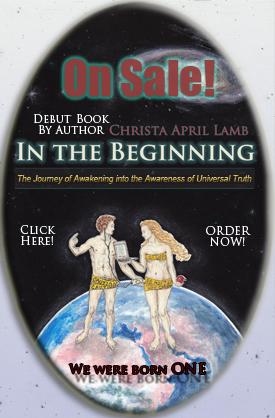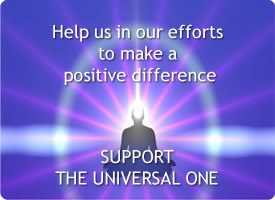The Universal Possibility of Peace
Posted By TheUniversalOne on April 2, 2011
The Universal Possibility of Peace
By Christa Lamb, 2009
The possibility of peace existing within the framework of our collective reality requires the understanding that the world we created exists through our failure to embrace this possibility of peace. We believe in the thought of peace, but not as something obtainable, at least in our lifetime. However, peace does exist. Within the constructs of what could be, within the internal world of our mind exists a realm where peace is obtainable, where ideas lives –where creation is at our finger tips and life is full of infinite possibilities. To understand this realm, we will venture into, but not bury ourselves within, quantum physics, sometimes called the study of possibility. We have to understand the potential of possibility, in order to see that Gandhi had it right when he said, “The way to peace is through peace.” It is not enough to merely observe peace, but to live our lives within the creation of peace.
Currently, our collective reality is built around a percept of false assumptions that we have adopted from generations before us. With each passing generation the realities of peace become more elusive, while the realities of fear; war, genocide, nuclear proliferation become an ever growing part of our collective reality. We see sufferings of conflict as the true reality and peace as the nice thought of what could be if only… you finish the sentence. There is a good explanation for why we view the world this way. Built into our mind set, we have a collective belief system that dictates that we exist in the world, rather than “we” making the world exist. We are merely the observers and not the creators. We have adopted this set of beliefs through religious dogmas, through separation and isolation from the world around us, through giving our individual power to another, and through choosing fear over hope.
We believe the world is what it is –and we spend our entire lives trying to justify it in our minds, rather than dreaming a new world where justification is not needed. What we fail to understand is that the internal dream is just as real as the external world in which we live.
Yet, imagination is more powerful than any bomb that could be dropped: it is the dreamer dreaming the dream. Imagination brought the bomb into existence –and imagination could bring that same bomb into extinction. This is fact, not fiction.
Brain scans show that when a person visually sees something a certain part of the brain becomes activated. The part of the brain that lights up is determined by what the person sees. For example, if a person sees a pretty face, the brain’s reward center lights up –simple, right? The interesting part is when a person is asked to think of a pretty face, the same part of the brain will light up as if the person is visually seeing it. The brain does not distinguish between what the eye sees and what it sees. This is why when we merely think of something that bothers us, we get upset. Another example would be to see an ex making out with someone else –it would make our stomach sick. We would have a physiological response to witnessing this act. Likewise, if we were to think back on this same act, we would once again get the same response. This is also true if we had never seen the act, but simply imagining our ex with someone else. The power of imagination is strong enough, that all we have to do is think of it, then believe it, in order to provoke a physiological response in our body.
Let us think about something for a moment. Our brain filters millions of bits of information a second from our retina; essentially we are talking Ethernet speeds. However, we are only aware of a few thousand bits of that information. There is a good reason for this. The brain has a built in processor. It can only process and store the information essential for the task at hand. If the brain were to process and store all the information we receive through the optic nerve, we would literally go into information overload. Imagine for a moment, you are in the grocery store and you need a bottle of Billy bee honey. You begin to walk through the aisles. Your brain has a task: the task is to find the honey. Out of the thousands of different foods, the millions of different brands, your brain has to filter through it all just to find one bottle of honey. The eye sees it all, but the brain only perceives what is relevant to task at hand. It will sort through all the different products until it finds the honey. Then it will sift through all of the different brands of honey until it sees Billy bee. Now what if your brain did not have the capacity to dump information that did not pertain to the task at hand? We would never find our honey. Our brain would become blogged down with information that is no more relevant to us than last week’s headlines.
What does all of this say about our brain? One thing it says is that what we have come to understand as reality exists within the brain. Our mind is constantly filtering information and making a determination every second as to what is important for us to know and what we can do without knowing. It is doing this without our knowledge, in order to serve a very real purpose. The most important thing to realize is the short-comings of this process. If we choose not to see peace in our mind as a real possibility then our brain will not store the information needed to make peace real. However, if we choose to accept conflict and war as reality, then our brain will store the information that shows us this is true. It will stir inside of us the fear, the worry, and the driving forces that perpetuate this type of thinking. Whether we are at war, or not, we will create the emotion of war inside of us –for us, it is real. Fear becomes our reality and our brain, serving its purpose, will continue to filter through the information gathered throughout a lifetime, just to meet its task. If we accept conflict as a real part of life, then conflict will be an ongoing reality in the world we create.
However, what if we taught the brain to filter through infinite possibilities? Restructured our brain’s receptors to respond with excitement to the idea of peace, equivalent to the emotional response we have to war? In theory, what if we rewired our brains to live within the imagination of possibility? Instead of fear being our automatic response to conflict, what if it was hope within peace?
Possibility surrounds us. The universe is made up mainly of something called dark energy. Dark energy cannot be seen, only its effects can be seen. Basically, we do not know what it is, but we know it exists. What we have come to understand as matter only makes up about 1-10% of the universe. Even within matter there is nothing substantial to it.
At the atomic level, we know the electrons circle the nucleus in empty space, never touching each other. The nuclei, although dense, is also filled with empty space. However, the empty space is not really empty since it contains the energy exchange between, for example, a photon and the electrons circling the nucleus. They are interdependent, while still existing separately. Each needs the other to function as a whole –even though the whole is filled with mostly nothing. This nothing is actively filled with the exchange of energy. In principle, what does exist is nothing; yet, every atom is filled with energy particles on a sub atomic level.
On a material level, the room I am sitting in is filled with empty space. The empty space surrounds the dense matter that I identity as a table, a couch, and a book case. I see this room within the reality of my mind. On a daily basis, I do not see the table as it truly is, but rather as a means to my end. I see it as a place where I can sit to eat, write, or place my belongings. I do not see the table for what it really is –for its molecular structure or the atomic compounds. I do not see that what I perceive as solid is really made up of space. It is made up of the same space that I see within the room –the space I overlook time and time again.
Even within us, we are made up of trillions of cells that are dying and being reborn at any given second. Within the cell there are about 7 quadrillion atoms and within the atoms, there are countless sub atomic particles. The smaller we get the bigger the number. Likewise, the bigger we get the larger the number. Consider how expansive the universe actually is –it is so big that we can only see horizon to horizon like we do on the earth. We are restrained by the universe itself. We cannot see a galaxy in light time that is farther away than the universe is old: this creates the horizons that are seen. We know that the nearest big galaxy to our Milky Way is called Andromeda. It is two million light years away. The farthest galaxies that we can see are 10 to 12 billion light years away. The number grows the farther we look and the number still grows the deeper we look.
This tells me something, whether we are looking across the universe, or looking into it on a subatomic level, two things remain consistent: one, it is ever expansive and growing and two, the entire universe does exist within a single cell. The deeper we delve into the subatomic world, the more we discover exists. It does not end. In theory, it could simple turn in on it self and reveal a whole other world on the other side. Likewise, the more we can see of the expansive universe, the more we can theorize exists beyond what we know. Is there another universe beyond what we see on the fading horizon? Or does it go on eternal? Or maybe what we see on the universal horizon is the other side to the subatomic world? This is what the universe is filled with –possibility! We cannot have science without imagination; without the ability to dream and believe that dream into reality, we would know nothing. We would be nothing. However, we are something. Our awareness makes us something within the possibility of nothing.
Inside, we have creation: we are the creators. The light that was born the day the universe was created exists within us. The entire universe exists within: God exists within. Each cell lives within this possibility and on a sub nuclear level we are all one –we live within the possibly of unity. We cannot escape it: this is the observer’s paradox within the quantum theory of superposition. There are an infinite number of possibilities at any given time and all are real. Possibility does not exist in a moment, but in every moment at all times.
Within this universe, the possibility of peace does exist. There is no conflict between galaxies, between solar systems, between planets, between earth and sky. There is no conflict other than the conflict seen by the mind –created by our perception. Galaxies do not go to war, nor do asteroids fight with planets. They exist to serve a purpose. It is not the act of destruction that is the source of conflict, but the fear within the mind that embraces it. We create war. We create suffering. In comparison, we can also create long lasting peace. We can create a world where healing is the focus; where suffering escapes the mind and leads us to a utopia of peace. This is not wishful thinking, but the reality we could have out of a trillion different realities. All we have to do is be the reality we seek. One atom at a time, one cell at a time, one heart at a time; we can be the beacons of peace. The light that exists within can spread out across the entire universe. All we have to do is add the energy of peace, the belief of its power to that light –and it will shine over all. Our conscious energy, our reality can be with the universe –as one, we can be at peace with the whole of existence.
The dilemma is not in the dreaming, but in the believing. It is an act of faith to say, “I am living in peace.” However, when I think of a trillion atoms living together in harmony, in peace within me –giving me life- I can’t help but to believe that close to 7 billion people living on a planet within a solar system, within a galaxy that exists in a universe too infinite to measure, I can’t help but to believe we can live in peace too. Imagine with me for a moment –remembering that possibility does not exist in a moment, but in an infinite number of moments at the same time –imagine if everyone decided in an instance to live in peace now, all the fighting would cease in an instant. The bombs would serve no purpose. Think of all the suffering that would end. Think of the tears that would stop flowing. Think of the weight that would be lifted from our shoulders. Just by believing we can live in peace, we would have obtained it.
It is not just a nice thought, but a reality we are destined to embrace. We cannot continue to live in conflict and expect to achieve unity. We cannot fight ourselves and expect to flourish. Our molecular makeup consists of co-habitation and cooperation –this is who we are. If my cells turn on each other I suffer. If we fight each other, we suffer. We do not accomplish great things in conflict. We accomplish them in community and in cooperation with our neighbor. Together, we either have peace, or we don’t –but either way, peace will always exist within us. Likewise, the possibility of peace always exists within the empty space created through the suffering of conflict caused by fear. Within the universe peace is always there, waiting for us to collectively say, “Yes, I want peace,” and then believe in it without fail, knowing within the mind peace is obtainable. It is real.










Comments